One part of creating these blog posts that I really enjoy is research. I do a lot of reading as I’m putting together the outlines and early drafts. My working document looks like the footnotes page of a college term paper. I had a dozen sources for the last one on the Padrão dos Descobrimentos and more for the Parque das Nações and Lisbon Food Tour posts.
When it makes sense, I’ll add a link to one or more of the sources. But more often than not, the research informs my thinking and helps me create a coherent (I hope!) narrative. Sometimes the research gets in the way of the writing and I end up going down rabbit holes, following interesting white rabbits until I’m lost.
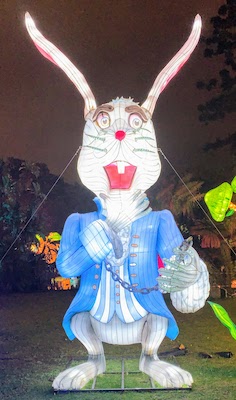
Other times, I find contradictory information. This is not really surprising, given that I’m doing my research on the Internet, using secondary and tertiary sources. But it’s sometimes surprising to find that what is presented as fact in one place is disputed in another place. This is particularly true when the subject is several hundred years old. More on that in a minute.
And occasionally, these trips down the rabbit holes lead me to interesting places. While researching the Padrão piece, I was looking for a picture of Prince Henry the Navigator. That led me to a site for the Museu Nacional De Arte Antiga – the National Museum of Antique Art in Lisbon. Henry was identified as one of the people in a large painting that hung there. I spent some time (too much!) cruising around the museum site and found notes about several other pieces from the Age of Discoveries period (15th – 17th centuries) that looked interesting.
Then I saw that admission was free for citizens and residents on Sundays. Bonus! So on a recent Sunday morning, Mary and I got together with our friends Carol and Paul and took the train into Lisbon.
The Museum
The MNAA is located in the Estrela district, on the south side of Lisbon, about a 15 minute walk from the Santos train station. It feels like it’s out of the way, so perhaps it doesn’t get a lot of tourist traffic.
The building is a 17th century palace that has been expanded over the years as the museum grew. The interior spaces are modern – open, airy, and well-lit.
The museum was founded in 1884. Its original collections were pieces from monasteries, convents, and royal palaces. Throughout the 20th century, the museum’s collection expanded through purchases and donations until today it has over 40,000 pieces of art, many of which are classified as “national treasures”.
The Things I Wanted to See
Out of the 40,000, there were several specific pieces that I wanted to see, so I led the way as we entered the museum. The first one was on the third floor, so we took the elevator to the top and worked our way back down.
The St. Vincent Panels
The first item was a large painting called “The St. Vincent Panels”. St. Vincent was the patron saint of Lisbon and the explorers during the Age of Discoveries. There are six panels, each painted on wood. It is considered one of the greatest achievements of Portuguese art.
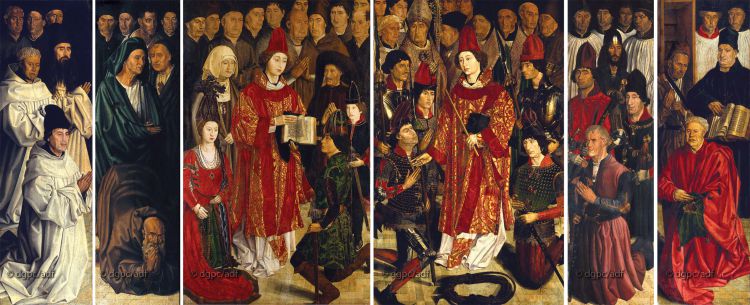
Image Source: Museu Nacional Arte Antiga
In two of the panels, we see the figure of St. Vincent, wearing a red dalmatic, a deacon’s vestment. He is surrounded by a group of 58 people who are thought to represent the royal court and different groups of Portuguese society at the time.
For over 200 years, the panels were hung at the Lisbon Cathedral, in a chapel where St. Vincent’s remains were buried. At some point, the painting was moved to the Mosteiro de São Vicente de Fora (the Monastery of Saint Vincent on the Outside, referring to the fact that the original 12th century church was built outside the city walls of Lisbon). The panels were found there in 1883 and later moved to the MNAA.
Who did it? When? Who’s in it? And which one is Henry?
The St. Vincent Panels are also the subject of controversy among scholars and art historians, who have debated for years about the details.
For starters, there is the question of who painted it? There seems to be a consensus that the artist was Nuno Gonçalves, the royal painter of King Afonso V, who reigned from 1432 until 1481. Gonçalves was active from 1450 until 1491.
Another question is when was it painted? The MNAA site dates it as “c. 1470”. Other accounts suggest it was painted in the 1450’s, because the painting includes images thought to be Prince Henry the Navigator. Henry died in 1460. (Of course, St. Vincent was martyred in 304, so being present to sit for the painting was not a requirement.)
Then there’s the big question of who is shown in the painting. St. Vincent appears in two of the panels. Next to him, in one panel, is a person in a large brown hat who is thought to be Prince Henry.
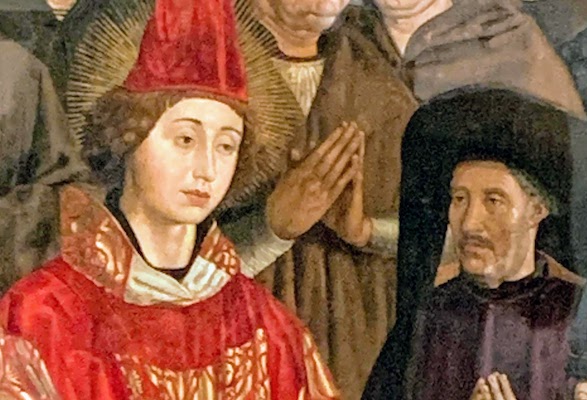
Identifying Henry is problematic, because there are no confirmed portraits of him. One scholar compared the likeness in the painting to another image thought to be of Henry in a 15th century book about the history of the Portuguese discoveries in Africa.

Other scholars have suggested that the man in the brown hat is Henry’s brother, King Edward, who reigned from 1431 to 1438. They argue that Prince Henry is actually shown in a different panel.

This “alternative hypothesis” also identifies several other people in the painting as members of King Edward’s family. Other figures, including those in the back row and in the outermost panels, are thought to be representative of different social groups surrounding the royal court in the mid-1500’s.
I’m sticking with the story that Henry is the guy in the brown hat, but I’m no scholar, so don’t take my word for it! (And remember, you’re reading this on the Internet.)
Getting a makeover
The panels are currently being restored in a three year project by an international team of conservators and art historians. The work is being done behind a glass wall in the museum, so visitors can see the work in progress.
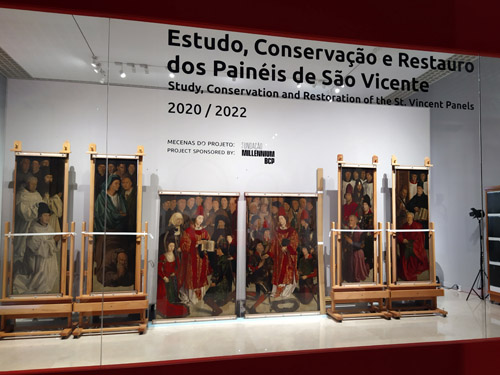
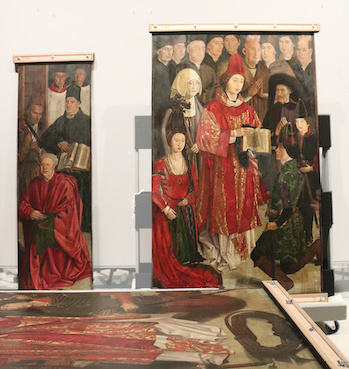
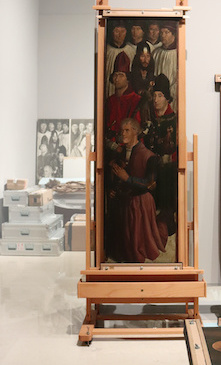
There is a large interactive display at the museum that provides detailed information about the panels and the restoration work. One of the sections shows a technique that is like an x-ray of the painting. It reveals that underneath the paint are outlines of the figures, some of whom didn’t end up in the finished work. (Somebody must have irritated the artist.)
If you’d like to go down the rabbit hole on this, you can learn more at these sites:
Study, Conservation and Restoration of the Painéis de São Vicente (St. Vincent Panels)
Painéis de S. Vicente – A casa do restauro (The house of restoration) The site is in Portuguese, but has some fascinating images, including the hidden sketches.
The Monstrance of Belém
A second interesting piece from the Age of Discoveries is the Monstrance of Belém.
What is a monstrance?
Maybe you already know, but I had to look it up. According to the Encyclopedia Brittanica, it is
in the Roman Catholic Church and some other churches, a vessel in which the consecrated eucharistic host (the sacramental bread) is carried in processions and is displayed during certain devotional ceremonies.

The MNAA calls this ‘the most famous work by a Portuguese goldsmith, recognised for its artistic merit and historical significance”. But again, there is some mystery.
What we know:
It was commissioned by King Manuel I for the Jerónimos Monastery in Belém. It was made in 1506 from gold brought back from India by Vasco da Gama.
What’s not certain:
First, what was the source of the gold? I found different origin stories. One said it was gold from da Gama’s first expedition. The MNAA site says it came from da Gama’s second voyage. Seems like that would have been written down somewhere. We’ll go with the museum’s version.
Second, who made it? The museum says it “can be attributed to” Gil Vicente, a Portuguese goldsmith. I have not found any other reference, so again, we’ll go with the museum’s story.
You can go down the rabbit hole for a detailed description of the Monstance.
Out of the rabbit hole and back into the sunshine
We enjoyed looking through the museum and admiring the paintings, sculpture, pottery, and even a few pieces of furniture on display. We’ll go back again.
There was another bonus to our outing: The museum is around the corner from La Boulangerie, the French cafe we visited during our Lisbon Food Tour. It was a warm spring afternoon, and we enjoyed lunch and conversation outside on their patio.
Thanks for coming along on this visit to the MNAA. And thanks to Paul Wilcox for sharing his photographs, including the featured image at the top of the post. You can see more of his work at WilcoxPhotoart.com.
Next week, we’ll be back to the 21st century.
What rabbit hole have you been down this week? Share your adventure in the comments below or with a note via the Contact Us form.
Until next week / Até a próxima semana
Mike
The Writer
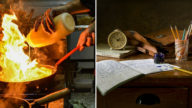
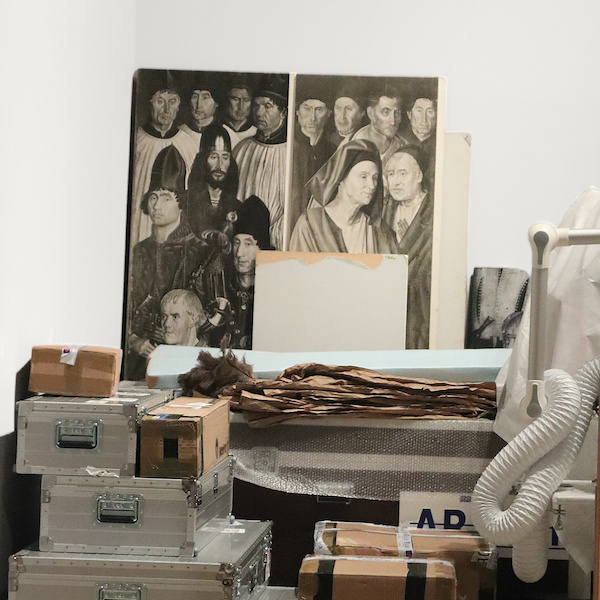

It’s a great time of year for rabbit holes with Easter right around the corner. I too love the research which comes in handy when planning trips or blogging for sure. Keep it up – I love reading all about it!
I enjoyed learning about your research process, Mike. I so love reading about your amazing lives. You and Mary are my spirit animals.
Xo,
Nan
Thanks again for the level of detail, very interesting piece of history/art.
Hi Pat,
Thanks for your note. I did feel like I was going down a rabbit hole with that post, so I’m glad you enjoyed it.
Enjoy your weekend, too.
Mike